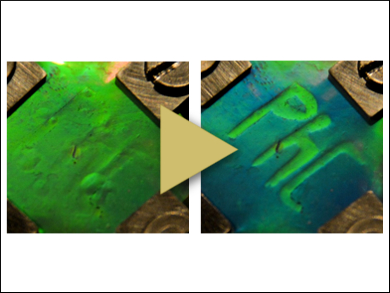Tao Ding, University of Cambridge, UK, and colleagues produced patterns in photonic crystals that are revealed only under the application of chemical reagents or mechanical strain. Such “disappearing photonic inks” could be used as anti-counterfeiting measures or for storing secret information.
The team used a shear-ordering process to produce polymer opal films (POFs) with ordered arrays of nanospheres having polystyrene cores, poly(methylmethacrylate) interlayers, and poly(ethylacrylate) shells. These elastic films can be bent, stretched, and imprinted. The researchers doped the films with a benzophenone photoinitiator, which produced free radicals under UV irradiation. Using masks and UV light, they “wrote” patterns of letters and numbers into their POFs that were not visible to the naked eye. The UV-exposed regions became more heavily cross-linked. When the films were stretched, these regions exhibited less strain, and they became visible as contrasting colors.
The researchers note that variable-opacity UV masks can be used to produce a range of colors in various parts of a film. POFs can also be immersed in various solvents to reveal the encoded patterns as the films swell. The best results were obtained using ethanol (vodka) as a solvent, leading to the possibility that POFs can be used as colorimetric alcohol sensors.
- Revealing Invisible Photonic Inscriptions: Images from Strain,
Tao Ding, Guoshuai Cao, Christian G. Schäfer, Qibin Zhao, Markus Gallei, Stoyan K. Smoukov, Jeremy J. Baumberg,
ACS Appl. Mater. Interfaces 2015.
DOI: 10.1021/acsami.5b02768



